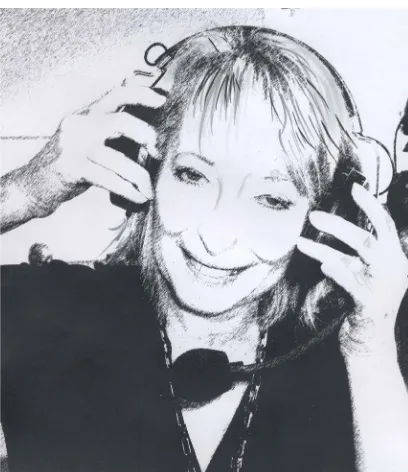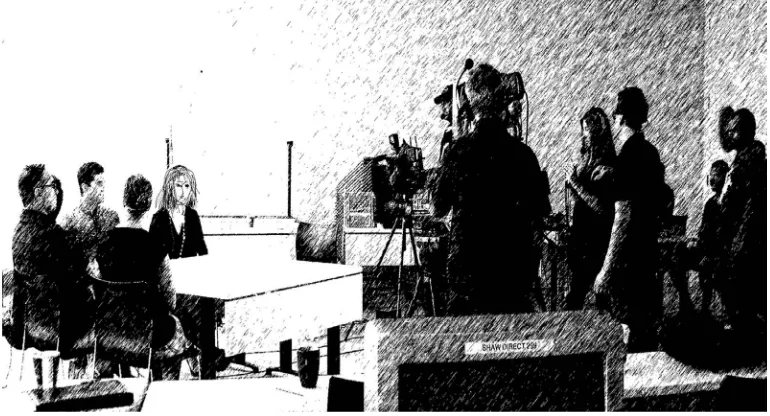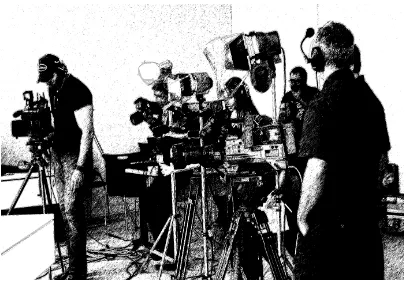http://dx.doi.org/10.4236/jss.2014.25028
Portrayal of Teachers in Popular Media:
Pushing the Frontier of Collaboration with
Media Business in Pedagogy and Technology
Orest Cap, Joanna BlackDepartment of Curriculum, Teaching and Learning, Faculty of Education, University of Manitoba, Winnipeg, Manitoba, Canada
Email: Orest_cap@umanitoba.ca, blackj@cc.umanitoba.ca Received May 2014
Abstract
This presentation is based on a unique Summer Institute at the University of Manitoba, Canada in which the presenters examined the relationship between pedagogy and the popular mass media from ([6] Butler, 2000; [12] Maruri, 2012) and beyond [11] Dalton (2010). The image of the tea- cher provides thematic explorations of school culture, pedagogy, human rights, equality, race, gender, bullying, poverty, stereotyping, and power relations [7] Bulman (2005). The authors of the paper describe a case study which was carried out in a Post Baccalaureate Diploma in Education and Master of Education program at the Faculty of Education over a two-week period in August of 2013 with 24 pre-service public school teachers and technical college instructors.
Keywords
Teachers, Business and Industry Collaboration, Popular Media, Quality Teaching, Partnerships with Business, Image of the Teacher in Films, Faculty of Education and Linkage with Media, University-Industry Cooperation
1. Introduction
tive learning communities where excellent pedagogical practices are developed and shared also requires leader-ship, collaboration and ways to address tensions between innovators and those reluctant to change” (p. 3). They further stress that with our institutions’ diminishing resources and increased national and international competi-tion, to survive and remain relevant need not only mean that we need to explore alternative pedagogies but we must also strategically co-operate with external stakeholders. Consequently, a closer connection with business and industries could provide authentic opportunities to acquire both generic and professional competencies. In a similar vein the authors of the [3] Business/Higher Education Round Table (B-HERT) position paper No. 7 pre-pared for the Business/Higher Education Round table of Australia (January, 2002) state in their conclusion that “… business and universities need to work actively to expand the current forms of partnerships and engagement. This should lead to a higher level of interaction and seamlessness between business and higher education”. However, according to [4] Houston (1986) as cited in [5] Boyer (1985) a caveat is in order. He feels that univer-sities have a unique mission and as result “… univeruniver-sities and corporations should built connections, but they must also protect their independence”.
Currently with the new admission standards in place for after degree teacher education programs at the Uni-versity of Manitoba, many of the teacher candidates are more mature, bring with them expertise in various sub-ject matter, beliefs, values and life experiences. As a result one would need to ask oneself if we as teacher edu-cators should utilize film pedagogy to strengthen teacher education by deconstructing and reflecting on film cur-ricula and take advantage of the prior knowledge of these neophyte candidates. [6] Butler (2000) stated that “… film pedagogy can also create spaces for helping pservice teachers develop a critical consciousness with re-gards to education” [and] “... helping them affect change in their classrooms”. The exploration of the image of the teacher via films could provide another source and avenue for the thematic study of school culture, pedagogy, human rights, equality, race, gender, bullying, poverty, stereotyping, and power relations [7] Bulman (2005). The portrayal of teachers on the silver screen provokes a strong reaction [8] Edutopia (2012) from viewers and, for better or worse, creates an influence on the public’s perception of the profession [9] Swetnam (1992). Teachers according to [10] Crume (1988) as cited in [6] Butler (2000) can be portrayed in a number of ways: positive (i.e. professional, idealist, friend, self-sacrificing hero), neutral (i.e. coach, love object) and negative (i.e. villain, adversary, buffoon, sex crazed, victim, mad scientist). [11] Dalton (2010) on the other hand refers to teachers as outsiders (i.e. renegade, temporary gig …), personally involved with students (relationships, sa-vior…), teachers learning from students andthe relationships between teachers and administrators. As such, the portrayal of teachers in popular media and the need to examine the relationship between pedagogy and the popular mass media from Hollywood ([6] Butler, 2000; [12] Maruri, 2012) and beyond ([11] Dalton 2010; [13] Dalton, 1995) should be included in a teacher education course. Our response to the stereotypical portrayals was to take on the task of designing a unique Summer Institute course on the “Portrayal of Teachers in Popular Me-dia” which was then held at the Faculty of Education, University of Manitoba, Canada.
In this paper the authors describe a case study [14] Spirer (1980) which was carried out in a Post Baccalau-reate Diploma in Education and Master of Education program at the Faculty of Education, University of Mani-toba over a two-week period in August of 2013. Through exposure to two new, innovative courses entitled, “Portrayal of Teachersin Popular Media: theory, analysis and pedagogy” and “Portrayal of Teachers in Popu-lar Media: production, art and technology,” the authors of this qualitative study report on how participants had an opportunity to explore the theory behind the rhetoric, and be better equipped to recognize how film works to communicate and inspire. The writers further briefly examine how a university faculty of education successfully merged pedagogical and technical digital video expertise with the cooperation of a major media (refer to Figure 1) conglomerate. Sample criteria for a designated assignment is shared with the reader.
2. Background and Brief Overview of University-Industry Cooperation
Figure 1. Pre-service teacher listening to the production created in conjunction with Shaw Cable.
Due to the rise of the more knowledge dependent economy the need for strategic partnerships [17] (Edmond-son et al., 2012) that go beyond the traditional research projects funding intensify this challenge. Currently Uni-versity-Business Cooperation (UBC) is undergoing a dramatic flux in relationships as indicated in a recent [18] (Ranga et al., 2013) final report prepared by the London School of Economics Enterprise which reviewed ten US and five case studies from Canada. The [19] European Commission (2009) similarly identified and reviewed thirty countries with good practice as examples in a number of areas of UBC. The [17] Science I Business Inno-vation Board AISBL reviewed fourteen cases of UBC from US and Europe including a section entitled “Part-nerships that impact teaching and learning”. Their research suggests four concrete lessons for bridging the in-dustry-university divide: 1) keep the “ship” steady; 2) provide universities the autonomy to operate effectively, and to establish partner ships; 3) encourage and reward via funding incentives strong partnerships and 4) assist universities to strive for excellence. In all three studies it was found that on the basis of the closely illustrated cases a broad diversity of fine examples exist in University Business Cooperation (UBC) and each call for greater partnership expansion and involvement and interaction between the workplace and higher education.
3. University–Business Cooperation and the Faculty of Education
training materials, and York University to help establish annual engineering and science Olympics for high schools students [20] Imperial Oil Foundation (2014).
4. The Summer Institute
The two new University of Manitoba, Faculty of Education Post Baccalaureate Diploma in Education and Mas-ter of Education graduate courses were scheduled over a two-week period in August of 2013 with 24 pre-service public school teachers and technical college instructors majoring in Adult Education. The two innovative courses were designed and delivered by Dr. Orest Cap, Dr. Joanna Black and Dr. Denis Hlynka. One half of the course was delivered at the Faculty of Education and the other half at the new facilities of the University of Ma-nitoba, School of Art. The six-credit summer institute focused on exploring the theory behind the rhetoric: to enable students to be better equipped to recognize how film works to communicate and inspire. An independent film producer within the filmmaking industry was invited via Skype to provide more in-depth information on the subject of filmmaking. In order to prepare students well, Shaw Communications gave on separate days an one hour in-class presentation focusing on the following topics: day I—dynamics of running a panel, duties of a moderator, addressing the audience and keeping to time within the television production process as well as tai-loring the content to fit the television format; day II—importance and use of the rundown sheets and how these help organize the production, mobile television crew examples in action, and the role of Community Access programming. In addition, two of the instructors explored images of teachers throughout history (screening of selected films, episodes of radio and television programs, symphonies—film scoring, folk and popular lyrics, discussion of the Hollywood curriculum and theory). One instructor focused exclusively on writing and ex-amining television content preparation including pre-production and production techniques, studio arrangements and tasks, lighting, directing, communication and switching techniques, camera shots, angles including camera movement (refer to illustrations). In a culminating activity, all students with assistance of television producers, and full broadcasting crew of a major media conglomerate—Shaw Communications Inc. Winnipeg had the op-portunity over three full days to take on every role related to digital television production (refer to Figure 2). Finally, the participants produced several specific short digital videos for live distribution to a wide Canadian audience via cable television. To facilitate students’ work, sample Institute assignments included specific guide-lines, analysis frameworks and rubrics.
The three instructors required participants to firstly produce individual blogs—which tracked their progress over the first week. The task was for each student to maintain five entries, approximately 500 words per blog entry. The blogs contained two parts. Part one provided an opportunity to interact with any course content pre- sented during that day while part two was to create a set of field notes for each film, television program or
[image:4.595.121.506.487.695.2]excerpt shown in class. Secondly, School Culture—participants were to select and present in class a DVD film from a given list, secure and view the film. They compared the selected clips of Hollywood school portrayal with realities of their experiences. They also were asked to consider culture, beliefs, values, instructional prac-tices, traditions, behavior rules, demographics of the school and its community. Lastly, students produced (planned, wrote, acted and were behind the camera in production process involved in pre-Production, produc-tion and postproducproduc-tion and their task was to examine media portrayals of teachers. Each of the designated groups created a five minute debate/discussion entitled “Conversations about Media Portrayal of Teachers” based on selected film clips. They were asked to share their own particular viewpoints about being a teacher in comparison to portrayals of teachers by film/television companies. The intent was to prepare content and be in-volved in a dynamic scenario dealing with a topical curriculum issue in order to demystify the media for the general Winnipeg public and to provide teachers with a voice they would be able to share with the community at large.
Each group had to aid other groups in class with their productions to make this assignment a truly “class community venture”. Sample mark breakdown and description for the production assignment follows:
5. Assignment 3 Debate/Discussion (Live to Tape)
25% pre-production (Preparation of the television production); 25% production (Shoot “live to tape” at Shaw Cable on August 28, 29); 50% postproduction (Final product and screening—students must be present August 30th)
The television production will be comprised of six groups in the class of approximately four people who will create a debate/discussion entitled, “Conversations about Media Portrayal of Teachers”. Students will be in-volved in the pre-production, production (refer to Figure 3) and postproduction television processes examining media portrayals of educators. The intent is to write content and be involved in a dynamic scenario dealing with a topical curriculum issue in order to demystify the media for the general Winnipeg public. Each group will aid other groups in the class with their productions to make this assignment a truly “class community venture”. As-signment Details: Each group will create an approximately five minute production in which five discussion points will be dealt with per group. An audience (comprised of members from our class) may have the option to participate at the end of each production in an approximately two minute discussion. The production involves 1 host who drives the discussion and, 3 to 4 members who address the issues through discussion/debate tactics in front of a live audience which will be filmed to tape. Make certain that a key educational theory/issue discussed in this class and/or the other class will be connected to the television production’s theme and issues. The pro-duction processes involve: 1) writing the content of the discussion/debate, 2) planning out the session, 3) plan-ning out one or two pertinent professional film/TV segments (of approximately 5 - 30 seconds) to be aired dur-ing your live filmdur-ing and referred to when in production; 4) reenactdur-ing the scenario and possibly actdur-ing in an audience; 4) learning about and being involved with television production (behind the scenes as Camera Person, Floor Director, etc.) and thus, being involved helping others in the class to bring their work to finished live tele-vision format; and finally 5) participating in the analysis-post production process.
6. Summary
Figure 3. Students learning about the television equipment Shaw Cable provided for the television shoot.
working with two of the teachers at the Summer Institute and their own students in the middle and senior years within the school system. This case study is another tangible example of how to foster “quality teaching” in higher education [2] Henard and Roseveare (2012) and, in addition, how a university faculty of education suc-cessfully merged pedagogical and technical expertise with media industry.
References
[1] Boyer, E.L. (1985) Foreword in N.P. Eurich, Corporate Classrooms: The Learning Business. The Carnegie Foundation for the Advancement of Teaching, Princeton.
[2] Butler, F.J. (2000) Hollywood Films, Reflective Practice, and Social Change in Teacher Education: A Bahamian Illu-stration. Doctoral Dissertation, Dissertation Abstracts International, McGill University.
http://digitool.Library.McGill.CA:80/R-?func=dbin-jump-full&object_id=36880&silo_library+GENO1
[3] Bulman, R.C. (2005) Hollywood Goes to High School: Cinema, Schools and American Culture. Worth Publishers, New York.
[4] Cap, O. (1975) Co-Operative Education Another Avenue to Learning. Education Canada, 25-28.
[5] Crume, M.A.T. (1988) Images of Teachers in Novels and Films for the Adolescent, 1980-1987. Doctoral Dissertation, Dissertation Abstracts International 50, University of Florida.
[6] Dalton, M.M. (1995) The Hollywood Curriculum: Who Is the Good Teacher? Curriculum Studies, 3, 23-44.
[7] Dalton, M.M. (2010) The Hollywood Curriculum: Teachers in the Movies. 2nd Edition, Peter Lang, New York. [8] Davey, T. and Baaken, T., Muros, G.V. and Meerman, A. (2011) The State of European University-Business
Coopera-tion. Science-to-Business Marketing Research Centre in Munster, Germany.
http://ec.europa.eu/education/tools/docs/uni-business-cooperation_en.pdf
[9] Dieffendefer, R., Kopp, L. and Cap, O. (1977) Business-Industry-Labor Linkages: A Handbook for Improving Person-nel Development Programs. The Center for Vocational Education, The Ohio State University, Columbus, ED150434- ED150440.
[10] Edutopia (2012) Five-Minute Film Festival: Hollywood Teachers.
http://www.edutopia.org/blog/film-festival-hollywood-teacher-movies
Partner-ships Work: Lessons from Successful Collaborations. Science I Business Innovation Board AISBL.
[12] Fisher, J., Belcher, R., Cairney, T., English, B. and Harding, S. (2002) Greater Involvement and Interaction between Industry and Higher Education. B-HERT Position Paper No. 7, Melbourne.
http://www.bhert.com/publications/position-papers/B-HERTPositionPaper07.pdf
[13] Henard, F. and Roseveare, D. (2012) Fostering Quality Teaching in Higher Education: Policies and Practices. OECD Publishing.
[14] Houston, R.W. (1986) Mirrors of Excellence: Reflections for Teacher Education from Training Programs in Ten Cor-porations and Agencies. Association of Teacher Educators, Reston.
[15] Imperial Oil Foundation (2014) A Partner in the Community, Calgary. www.imperialoil.ca
[16] Maruri, K. (2012) Hollywood Portrayals of Teachers: The Role of Cognitive Dissonance in Critical Pedagogy. Master Thesis Submitted to Gonzaga University, Spokane.
[17] Ranga, M., Hoareau, C., Durazzi, N., Etzkowitz, H., Marcucci, P. and Usher, A. (2013) Study on University-Business Cooperation in the US. Final Report, LSE Enterprise Limited, London School of Economics and Political Science, London.
[18] Spirer, J.E. (1980) The Case Study Method: Guidelines, Practices, and Applications for Vocational Education. The Center for Research in Vocational Education, The Ohio State University, Columbus.
[19] Swetnam, L.A. (1992) Media Distortion of the Teacher Image. JSTR, 66, 30-32. http://www.jstor.org/stable/30188962 [20] Talaba, D. and ten Thij, H. (2007) Teaching and Research Synergy in the Context of University-Industry Cooperation.
ZkP-Chevalier de Seyn Publishers, Eindhoven.


